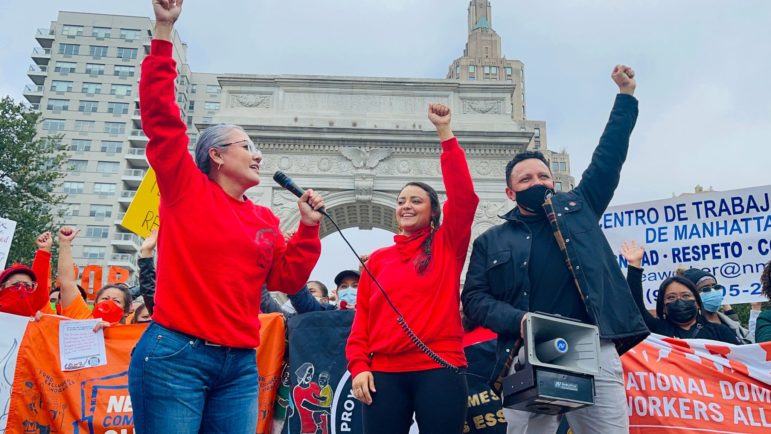
Last spring, when New York State passed its 2021-2022 budget, it included $2.1 billion for “excluded workers”—an effort to aid the thousands of low-income New Yorkers, including undocumented immigrants, who lost income during the financial devastation of the COVID-19 pandemic but weren’t eligible for unemployment benefits and other types of government relief.
Approval of the landmark fund was a major victory for its supporters, who’d fought for months to get it off the ground, marching across bridges and waging a weeks-long hunger strike to stress its necessity to lawmakers. While the $2.1 billion set aside for the fund far exceeded the amount of money available to excluded workers in other states, like California, it was clear from early on that it might not be enough to meet demand: the fund was estimated to aid around 290,000 beneficiaries, despite New York City alone being home to an estimated 560,000 undocumented people.
Now, two months after the Excluded Workers Fund began taking applications, it’s running out of cash. The state’s Department of Labor, which is administering the program, is warning on its website that the fund is “nearing exhaustion” and cannot guarantee that future applicants will be approved for relief. “Soon new applications will no longer be accepted,” the DOL’s website reads.
Workers and activists who pushed for the program are now calling for the state to allocate additional money for the fund, saying cutting off access now would unfairly impact workers who are eligible but have been slow to receive information about it or amass the documentation required to apply, particularly immigrants in rural areas upstate.
So far, the state has dispersed more than half of the $2.1 billion available to some 116,503 applicants, accounting for just over a third of those who applied. Nearly all of those payments were for the maximum or “Tier 1” amount available under the fund, up to $15,600 per applicant. More than 235,000 of the applications the state received so far came from New York City workers alone, data shows.
City applicants accounted for more than 80 percent of beneficiaries so far despite being home to 73 percent of the state’s undocumented workers, an analysis from the Fiscal Policy Institute last week found. Meanwhile, applicants around the capital region in Albany have made up just 0.3 percent of the fund’s beneficiaries despite being home to 1.4 percent of the state’s undocumented workers, the same report says.
In a statement, a spokesperson for Gov. Kathy Hochul did not specifically address the calls to expand the fund but noted its effectiveness so far in quickly reaching workers in need.
“Working with community partners and advocacy groups, this successful program has already delivered more than $1 billion to tens of thousands of New York families who were not eligible for state and federal unemployment insurance benefits, many of whom were essential workers,” spokesperson Hazel Crampton-Hays said.
“Within the next few weeks, more than $2 billion, the maximum amount authorized by the State legislature, will have reached the pockets of hardworking families across the state,” she added. “The Governor remains focused on helping our most vulnerable communities as we continue to rebuild and recover from the pandemic.”
A note on the DOL’s website states that applications will be approved on a first come, first serve basis, but that the state “cannot guarantee that funds will be available” for those who applied after Sept. 24.
“The need is still great—particularly for undocumented workers upstate,” State Sen. Jessica Ramos said in a statement, adding that “there are people out there who have gone through the time-intensive application process with no guarantee of success.”
“The money is there, and the opportunity to set a national standard for immigrant workers must be met,” she added.










2 thoughts on “As NY’s Excluded Workers Fund Runs Out of Cash, Advocates Press for Expansion”
I don’t receive any money from excluded workers fund, after deny appled already but not approved. Lavor department by mistake give me one week unemployment money after that no more money also & I don’t have job long time but I did tax file 2019 w2 & also I have all documents but still I don’t get any money.
I don’t receive any money from excluded workers fund but i Appeled already & also I have all documents & also I did tax file 2019 w2